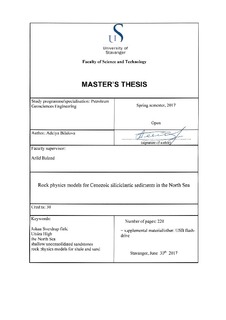| dc.contributor.advisor | Buland, Arild | |
| dc.contributor.author | Bilalova, Adelya | |
| dc.coverage.spatial | Norway | nb_NO |
| dc.date.accessioned | 2017-11-07T10:20:22Z | |
| dc.date.available | 2017-11-07T10:20:22Z | |
| dc.date.issued | 2017-06 | |
| dc.identifier.uri | http://hdl.handle.net/11250/2464553 | |
| dc.description | Master's thesis in Petroleum Geosciences Engineering | nb_NO |
| dc.description.abstract | The Norwegian North Sea is a huge and mature hydrocarbon province which has been mapped extensively since the discovery of oil and gas in the late 1960s. There is a numerous amount of data that is available for companies work and various studies. It is an area of multidisciplinary interest, such as, geology, geochemistry, geophysics or petrophysics. However, some investigations of the area are vague, challenging and remain open. In particular, the questions related to prediction of seismic velocities of shallow sediments in the Utsira High in the North Sea. High pore pressure predominantly associated with shallow unconsolidated sediments presents a significant hazard during drilling and completion of offshore wells. Hence, defining overpressured intervals before drilling not only diminishes drilling hazards but also reduces drilling cost. The correct rock physics model can be a key element in predicting overpressure. The standard Greenberg and Castagna rock physics model showing the empirical relationship between compressional and shear wave velocities has been applied for unconsolidated shallow sediments in the North Sea. Observation from a particular well in the Johan Sverdrup field is shown to indicate that this model works for deeper formations, but seems not to be valid for shallow sediments. One possible reason for this could be a low effective pressure appropriate to their environment. Therefore, in the thesis we aimed to define proper rock physics models for Cenozoic siliciclastic sediments in the North Sea based on laboratory data and well logging models. The laboratory data analysis motivated for a power model as the best model for sonic modeling on well logs. Testing of the power models for Vp and Vs did not give proper results on well logging data. Thus, inspired by Faust we derived second sonic models for Vp and Vs prediction. We found that resistivity is an essential parameter that should be included to the models. Furthermore, we realized that models should be estimated in every well separately. The comparison of our sonic models with the standard Greenberg and Castagna empirical model showed that our derived models behave appropriately in the shallow formations up to the depth around 1100 m TVDML where the standard Greenberg and Castagna empirical model breaks down. This is the depth that we got using porosity trend together with Murphy’s porosity boundary between unconsolidated and consolidated sand which is equal roughly to 35%. Consequently, we can claim that our final sonic models are correct for unconsolidated siliciclastic sediments. | nb_NO |
| dc.language.iso | eng | nb_NO |
| dc.publisher | University of Stavanger, Norway | nb_NO |
| dc.relation.ispartofseries | Masteroppgave/UIS-TN-IPT/2017; | |
| dc.subject | Johan Sverdrup field | nb_NO |
| dc.subject | Utsira High | nb_NO |
| dc.subject | the North Sea | nb_NO |
| dc.subject | shallow unconsolidated sandstones | nb_NO |
| dc.subject | rock physics models for shale and sand | nb_NO |
| dc.subject | petroleumsgeologi | nb_NO |
| dc.subject | Nordsjøen | nb_NO |
| dc.title | Rock physics models for Cenozoic siliciclastic sediments in the North Sea | nb_NO |
| dc.type | Master thesis | nb_NO |
| dc.subject.nsi | VDP::Matematikk og Naturvitenskap: 400::Geofag: 450::Petroleumsgeologi og -geofysikk: 464 | nb_NO |
| dc.subject.nsi | VDP::Teknologi: 500::Berg‑ og petroleumsfag: 510::Geoteknikk: 513 | nb_NO |
